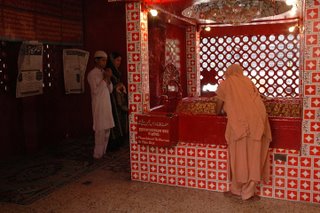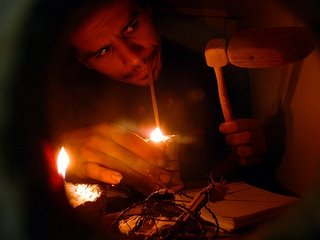Note on the discussion on Performance Art, which followed the Video presentation by Paulo Nazereth on his works, and works of some other Brazilian Performance Artists
Participants:
Diane Torr
Paulo Nazareth
Anousha Lall
Sushil Kumar
Oreet Ashery
Sonia Khurana
WuYe
Anita Dube
Rahul Bhattacharya
Paulo’s presentation was an occasion for a discussion on performance art and the nature of critical theory around it. It was almost inevitable that the discussion would start using the videos shown as a springboard for raising questions. Oreet in reference to the video, which captures Paulo walking into an eatery, dressed in a suite and ‘blind folded’ by slabs of meat asked whether the suite was a symbol of any kind of power. She went on to ask how consciously Paulo worked within the realm of counterculture... especially in the context of economics and race.
Paulo consciously chose not to go in for a direct reply and instead threw in a reply, which served as the keynote statement for the evening:
”There are political people and there are artists. Work needs to be seen through different kind of windows... one can also engage with the form.”
One could sense a feeling of surprise as Paulo’s translator Mirea made his statement available in English. I guess the manner in which we had looked at his work nearly ‘limited’ it to being ‘political’ and ‘activistic’ and in a certain sense failed to understand his formal plays.
Pooja stepped into the moderators’ role...turned to Oreet: “Where is your Art coming from”
Oreet: “well it comes from my interst in social realities...especially crossings between feminism and sexuality”
Pooja: “where does your take on sexuality come from”
I expected Oreet to give a concise ‘self history’...her experience in Israel, especially as a weapons trainer in the army, questions of marriage and the encounters with her sexual orientations.
Don’t know if Oreet caught the question right...she went on to give an account of various takes on sexuality done within the context of ‘Performance’. She then proceeded to express a concern about performance becoming ‘too mainstream’, and how over the ten-fifteen years it has really become ‘fashionable’ to have ‘Performances’ at various Art show openings. Oreet further observed that the proliferation of ‘reality TV’ shows has made ‘Performance’ mainstream even within popular culture and maybe in a certain way this has diluted the radical possibilities of Performance.
At this point Pooja tuned to Diane and asked for her take on the discussion so far.
Diane: “I have done a lot of collaborative work”
She went on to give an interesting account of a development within ‘Performance’ which focuses on group collaborations and centers around marginalized geographical groups and spaces. Influenced by Guy Debord’s Society of the Spectacle, and other critical texts centered on alienation of social experience, a form of Performance has developed wherein a group gathers in a socially invisible geographic space, enact a ‘ritual’ and suddenly vanish, but through enactment of the meeting resist and possibly subvert the culture of ‘alienated consumption of the spectacle’ which has been dominating our social experience. Diane went on to suggest that a city like Delhi provided a rich ground fro such ‘Performances’
I have my own takes on Guy Debord’s text and the euro centric Marxist bias that it encodes. For me both the ‘spectacle’ and ‘alienation’ have their own pre modern and non ‘Occidental’ histories and I felt that that the ‘marginalized/vanishing geographical spaces’ project sounded like that it can lapse into being a tokenistic romantic engagement with the past...casting it in a certain mould of purity. Moreover the project may have its own relevance within the context of Europe’s negotiations with modernity. However to assume that the project would have a similar relevance in the Indian context seemed very problematic.
As I was trying to make this point through the thunder of a low flying air craft, Oreet made came in with an interesting observation about the ‘counter economics’ of being a performance artist.
Touching back upon her earlier comment about Performance becoming (too) mainstream, Oreet:
“A lot of really strong performance art survives due to different kinds of networks of small artists supporting each other and this mode of linking also facilitates a lot of crossovers”
She further went on to express serious misgivings about the manner in which performance art is written about, and how art criticism is struggling to write about Performance. Mentioning the 80’s Oreet sited the coinage of the term ‘Live Art’ to ‘release performance art from the disciplinary limitations arising out of the links between ‘Performance’ and ‘Performing’. Continuing to voice concern over critical writing on performance art, Oreet referred to the birth of ‘relational aesthetics’, which as a response to ‘high modernist’ Formalism seeks to ‘value’ works of art on the basis of their contextual role-playing and the semantic significance of such in the realm of social relationships. She went on to observe that in the recent times ‘relational aesthetics’ has come in for its share of revisionalism and there has been a certain (ill understood) going back to ‘form’.
Sonia came in to comment:
“the manner in which Performance has/is being suddenly co-opted has had an adverse effect on critical theory”
She reminded us of the voice claim proclaiming loudly across New York and London, claiming Performance as the art of the 21st century. Sonia went on to pose a polemical question as to what happens to the contextual nature of Performance when it enters the Tate Modern.
The discussion was taking interesting turns...in a residency held in the context of Performance having a marginal space within artistic practices in India; suddenly there was a burst of lament about a certain loss experienced in Euro-American circles over Performance loosing its subversive potential by becoming too mainstream.
This stream of thought was temporarily broken,
Diane: “Performance Art allows you an immediate way to make a statement”
Anousha: “The definition of Performance is dominated by visual artists”
...Referring to the dominant trend of using performance towards making political/positional statements...she went on to say:
“It seems as if there is a need for a manifesto”
Diane: “visual art is very imperialistic with terminologies...
But actually there are various different impulses coming in from dance that have a significant role to play on how the history of performance has shaped up.”
She referred Merce Cunningham’s collaboration with John Cage as an early endeavor from within the realms of dance to de-establish the disciplinary understandings of dance...and a significant moment in the history of performance.
Anita: “there is very little space sub-cultures get inside the elitist definition of performance.”
She went on to express in the possible languages of performance...further stating that as a visual artist she was drawn towards performance as a medium that facilitates a certain nature of immediacy in reaction and enables her to express ‘spontaneously’.
At this point Pooja raised a question about the kind of background performance artists came from.
Oreet: “Performance artists come in from very difficult back grounds”
Diane: “what about the possibilities of political engagement through performance in India”
Pooja: “in the context of theater India has a rich tradition of political engagement especially IPTA...and we also have history of political activism through street theater...”
Oreet: “Globally art is going through its most conservative phase”
Paulo: “In Brazil older artists have a way too activistic definition of performance, and they recognize only a very loudly political pieces as being good performance”
Paulo again managed to surprise us all...all of us were still viewing his works chiefly within the category of ‘political’. However Paulo has a great knack for making people stop and think...and then think again. I suddenly realized that Paulo’s statements were leading me to better appreciate the poetic quality of his pieces...their layered levels of metaphor use.
At this point Anita and I started marveling about Latin American and Chinese performance and how artists like Song Dong, Danniel Sariva or Paulo make stunningly strong political commentary trough the use of highly poetic acts...minimal production backup...often enacted in isolated environments and documented (dramatically) in video.
Soon it became absolutely impossible to take notes as the discussion broke up into pockets of cross exchanges. The discussion that stayed on with me started with Anousha revisiting Anita’s earlier statements about sub-cultures and their space within the discourse of performance.
Anousha however, framed it combining Anita’s statement with her concerns about the discourse around Performance being Euro-American in its conceptual framework that while sketching a narrative about performance in India, we tend to ignore various traditional forms of Performance.
Catching up with Anousha, Anita reiterated her discomfort regarding the mainstream definition of Performance, and how one should get into dialectical relationships with the etinic/traditional forms of Performance...and try and be able to define it as Performance.
Sushil had walked in a while ago and was trying to understand the various strands of conversations floating around the space. He joined in with Anousha to voice extreme discomfort with what came across as Anita’s desire to voice extreme discomfort with what came across as Anita’s desire to appropriate various sets of scattered practices under the umbrella of ‘Performance’.
This ‘attack’ forced Anita to clarify her stance and probably rethink a bit. She expressed her desire to work with the various (sub-altern) forms of Performance, use their formal approach and radicalize them in terms of contemporary notions of subversion. She mentioned that Sushil and she were planning a Performance chanting the Ram Charit Manas or rather using the form of Ram Charit Manas, but using pornographic or politically subversive textual input.
Though I kind of understood what Anita was getting at...but we have to be very careful/sensitive about the imperialistic appropriative tendencies of High Art practices. Anita’s internationality definitely has a great relevance within the discourse of High Art. However that evening, the discussion was centered on revisiting the definition of Performance and some of us sitting there celebrate Performance as a medium, which has the potential to break the boundaries of ‘high’ and ‘popular’ within artistic practice...and as a praxis, which radically redefines art. Therefore it is only natural that we would be very sensitive to any urge, which suggested any reiteration of the ‘high’ and ‘popular’ divide; and also threatens to decontextualise practices which have very strong histories of their own.
By this time Rohini and Aastha had also joined the group.... somehow a certain strand of the discussion went back to gender and Performance...someone (I think Diane) made a remark about the video presentation and discussion which took place a few days ago featuring the works of Shantanu Lodh and Mrs Manmeet & Inder Salim, and where artists are invited to share a significant artwork and or an aspect of their practice, followed by open discussion with the audience. All of us have/had very strong opinions on their works...and very soon there was complete anarchy.... the ‘discussion’ eventually broke up....but even as it did I remember Rohini’s voice coming out strongest.......................................................................................................................
Rahul Bhattacharya.
 hey everyone......check it out....oreet's script for the open day....really interestin stuff
hey everyone......check it out....oreet's script for the open day....really interestin stuff




